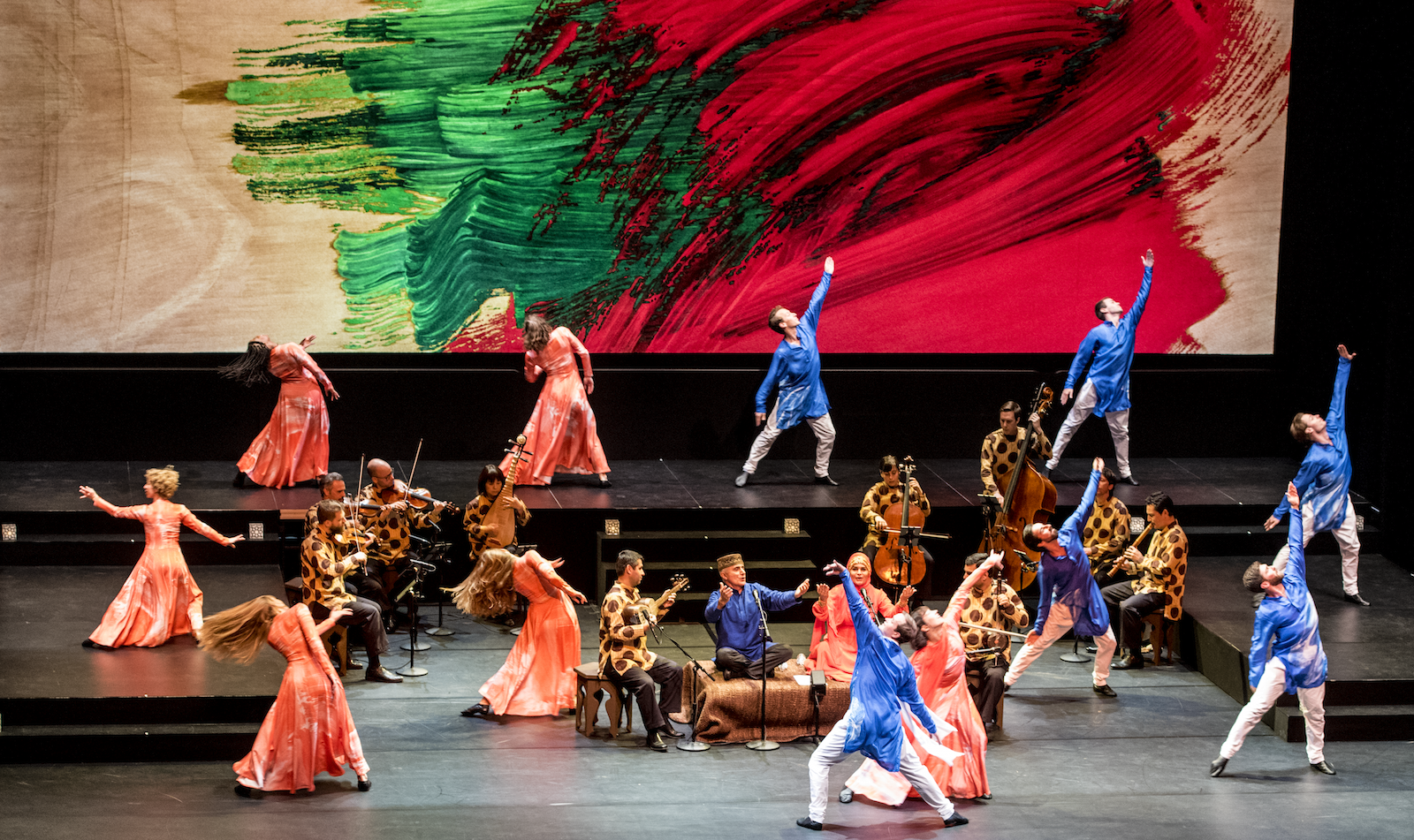
Layla and Majnun
Premiere
Cal Performances
Zellerbach Hall
Layla and Majnun is a Mark Morris Dance Group/Cal Performances, UC Berkeley, California, production in association with Harris Theater for Music and Dance, Chicago, Illinois; Hopkins Center for the Arts, Dartmouth College, Hanover, New Hampshire; The John F. Kennedy Center for the Performing Arts, Washington, D.C.; Krannert Center for the Performing Arts, Urbana-Champaign, Illinois; Lincoln Center for the Performing Arts, New York, New York; Meany Center for the Performing Arts, Seattle, Washington; Melbourne Festival, Victoria, Australia; Sadler’s Wells, London, England; and University Musical Society of the University of Michigan, Ann Arbor.
Media Gallery
- videos

Details List
| Choreography | Mark Morris |
| Music | Uzeyir Hajibeyli - Layla and Majnun |
| Libretto | Uzeyir Hajibeyli (based on the poem by Muhammad Fuzuli) Translation by Aida Huseynova and Isabelle Hunter - Libretto (PDF) |
| Scenic Design | Howard Hodgkin |
| Lighting Design | James F. Ingalls |
| Instrumentation | kamancheh, tar, shakuhachi or clarinet, pipa, two violins, viola, cello, bass, percussionist |
| Number of Dancers | 16 |
| Runtime | 60 minutes |
Details
Layla and Majnun is a classic story of love well-known across many Middle Eastern and sub-continental cultures; Muslim, Sufi, Hindu, and secular. Layla and Qays, are in love from childhood but are not allowed to unite. Qays (called Majnun, which means “possessed”) is perceived to be mad in his obsession with Layla. Layla is married off to another and Majnun becomes a hermit, devoting himself to writing verses about his profound love of Layla. Although they attempt to meet, they die without ever realizing a relationship.
This evening-length work features singers Alim Qasimov and Fargana Qasimova and musicians of the Silk Road Ensemble on traditional Asian instruments (kamancheh, tar, shakuhachi, and pipa) combined with Western strings (two violins, viola, cello, and contrabass) and a percussionist on stage with 16 dancers of the Mark Morris Dance Group.The late Howard Hodgkin, esteemed English painter and expert collector of antique Mughal miniature paintings, designed the backdrop and costumes.
The work opens with one of the following medleys, sung by two mugham vocalists and accompanied by musicans playing the kamancheh and the tar:
Bayati Shiraz
All pieces in this medley are based on the melodic patterns of Bayati Shiraz, which is one of the major mughams of Azerbaijani music. The composition proceeds from the melancholic and sad music expressions toward the upbeat and playful closing piece; such development is highly typical for Azerbaijani traditional music. The medley opens with the famous Azerbaijani folk song, “I have watered the street” which is about the girl who is waiting for her beloved and wishing that they never be separated.
The second part of this composition features the actual mugham Bayati Shiraz where both singers and instrumentalists demonstrate their ability to improvise. The song “You have been apart from me” is a closing part of the medley. Alibaba Mammadov (b. 1929), Azerbaijani mugham singer, composed this song following all the rules and stylistic features of the traditional songs known as tasnifs. A tasnif is a romance-like lyrical song that is usually performed within mugham composition. This medley, therefore, features three vocal genres of traditional music of Azerbaijan: mugham, folk song and tasnif.
Shushtar
All pieces in this medley are based on the melodic patterns of Shushtar, which is one of the major mughams of Azerbaijani music. The composition proceeds from the melancholic and sad to the upbeat and playful; such development is highly typical for Azerbaijani traditional music. The medley opens with a famous folk song, “Loneliness is painful,” which is about the love and longing for the beloved. This second part of this composition features the actual mugham Shushtar, where both singers and instrumentalists demonstrate their ability to improvise. Mugham Shushtar is followed by a traditional song known as tasnif. A tasnif is a romancelike lyrical song that is usually performed within mugham composition. Tasnif “Come to me, my deer” is a joyful and humorous expression of love. The title and the lyrics of this last piece feature a common metaphor of Azerbaijani poetry, a comparison of a beautiful girl to a deer. This medley therefore features three vocal genres typical for the traditional and folk music of Azerbaijan—mugham, tasnif and folk song.
Act I: Love and Separation
Act II: The Parents’ Disapproval
Act III: Sorrow and Despair
Act IV: Layla’s Unwanted Wedding
Act V: The Lovers’ Demise
It is “a visually, musically, and choreographically unified and self-contained concert piece. An enlightening tragedy.” – Mark Morris
Layla and Majnun is made possible, in part, through the MMDG New Works Fund with support from the Friends of MMDG, the Doris Duke Foundation for Islamic Art, Howard Gilman Foundation, Ellsworth Kelly Foundation, Elizabeth Liebman, a special grant from The Henry Luce Foundation, PARC Foundation, Poss Family Foundation, the National Endowment for the Arts, and the Trust for Mutual Understanding.
Funding has also been provided by the New England Foundation for the Arts’ National Dance Project, with lead funding from the Doris Duke Charitable Foundation and The Andrew W. Mellon Foundation, with additional support from the National Endowment for the Arts.
Press Quotes
-
"Mr. Morris does not so much tell the Layla-Majnun story as refract it, ritualize it, multiply it. The emphasis is all on emotion...Mr. Morris’s choreography deconstructs and distills the poetic legend with charm and taste."
New York Times -
"Inevitably, as the 65-minute work progresses, you find yourself immersed in something organic and wonderful."
San Francisco Chronicle -
"...a delight. The piece, slightly over an hour long, combines—with concision, precision, heart and brio—all the qualities that are best in Morris’ aesthetic...this classic tale...gives us a new lens through which to delight in a superb dance maker, with a company to match."
San Francisco Classical Voice -
"the dancers move through and around the musicians, and this intertwining gave the piece a coherent visual identity and a flowing energy. ***** 5 stars"
Bachtrack

